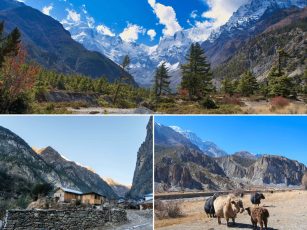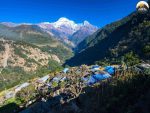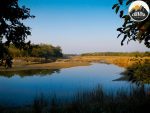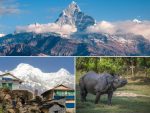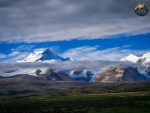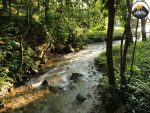Annapurna Circuit Trek is one of, if not the best, trekking routes on the face of this planet. Nepal Annapurna circuit trek is adventurous, mesmerizing and promises to make memories to cherish for lifelong. Thousands of trekkers set their foot on the mountainous northern side here in Nepal, and here are numbers of trekking regions for you to choose from. So, it is entirely upon you to set the best trekking journey on one of these popular hiking routes in Nepal. In this post, we are highlighting some important information on Annapurna Circuit Trekking.
| Trip Facts | Annapurna Circuit Trek Guide |
| Duration | 15-20 Days |
| Distance | 170-230 Km (Depends on itinerary) |
| Starts In | Besisahar/Syange/Jagat/Chame/Manang |
| Ends In | Muktinath/Jomsom/Nayapul |
| Permits Required | TIMS and ACAP |
| Highest Altitude | 5416m/17769ft (Thorong La Pass Trek) |
| Difficulty Level | Medium to Difficult |
| Accommodation | Guest House, Tea House, Lodge |
| Spending | Medium |
| Best Season | Spring (March-May) and Autumn(September-November) |




Annapurna Circuit Trekking
Nepal Annapurna Circuit Trek Highlights
- Mind-settling view of Mt. Dhaulagiri(8167m), Nilgiri(7600m), Annapurna (8091m), Annapurna South(7219m), Tukuche Peak, Dhampus Peak, Gurja Peak, Thapa Peak and other stunning peaks around. Highlighting all the height is a holy mountain, the Fishtail @ 6953m, is a virgin mountain.
- Wholesome view of Chulu east and west with the perfect accompaniment of desert landscapes of Manang where you see Yak and Blue sheep grazing.
- Superb clear view of Mt.Annapurna II (7940m), Annapurna III, Annapurna IV, Gangapurna, Khangsar Kang and marvelous Tilicho Lake.
- Satisfy your senses and soul by visiting one of the holy temples, the Muktinath temple, where Lord Vishnu is paid homage
- The rich, deep, green Marshyangdi river valley allows one to enjoy high hills and green bushes until Dharapani.
- One of the adventurous hikes to Tilicho Lake, the only highest lake in the world at 4980m above sea level.
- Encounter and observe green hills, beautiful landscapes, and rice terrace fields until you reach Jagat.
- Indulge and participate in locals’ culture, customs, traditions and unique lifestyle.
- Mind settling view of Mt Manaslu (8153m) and Ngadi Chuli (7800m).
- The fantastic colour play of nature with green fields and desert land.
- A pleasant drive experience from Kathmandu to Besisahar
- Natural hot spring bath at Chame
Annapurna Circuit Trekking is one long trekking trail. As you explore different facets during this Annapurna round trek, you will have casual encounters with peculiar villages, forest areas, staggering snow-capped mountains and greener hills. Usually, hiking the Annapurna circuit is possible within 15-20 days, but the total depends on various factors. Firstly, unpredictable weather, so weather halts increase your total trek duration. Secondly, the number of days changes as the itinerary changes. You should engage in this Annapurna round trek taking the sweet time of yours, reducing AMS symptoms and making memories with mountains. Difficult Rugged terrain, moderately high altitude and weather unpredictability make the trip challenging. Annapurna Circuit Trek is ideal for those looking and planning a long natural romantic holiday where you can be playful with master nature’s creation.
Annapurna Circuit route renders experience not to be forgotten ever. The sensation of cultural, natural richness in the Annapurna Circuit trek is not your everyday feeling.
Circuit Trek of Annapurna is one arduous trek with a total trek distance coverage of 170 and 210km. Yes, trekking is not so easy, but what matters is the journey, story, and of course, eye-widening sceneries magically crafted by nature.
This blog gives you information on the best routes for the Annapurna circuit, the best season for the trek, and other details. Please go thr\ough all the information here in this blog of Raconteur Adventure. The more you gain the necessary information, the better is your preparation.

Where to start?
Annapurna circuit trek became public in the year 1977 for all travelling communities in the world. The trend shows that most trekkers’ preferred start point for the Trek is Besisahar, Lamjung district. Bulbule is, of course, another sweet spot to commence the Annapurna trek. Bulbule is 7km ahead of Besisahar. You can take the local route bus from Kathmandu to reach here. It depends on you for starting point to take. Some even go to Manang and begin to trek from here. As the remote country is seeing its fair share of development, roads condition are getting better, and you can even drive to Manang. Some popular commencing point for hiking the Annapurna circuit is given below:
Besisahar: The most popular and oldest starting place is Besisahar. However, as road networks are being built to reach other destinations, it is being utilized as a starting point less frequently these days.
Bhulbhule: Located 7 kilometres ahead of Besisahar, Bhulbhule is still a popular starting location. From Kathmandu, you can take the bus or a car provided by your trekking service to Bhulbhule.
Syange: Located 22 kilometres north of Besisahar, Syange is a popular starting place for hikers. Accessible by Jeep, and you may stay the night here before beginning your trek the next day.
Jagat: Jagat is located 30 kilometres north of Besisahar and may be accessible by Jeep. If you begin your Trek at Bhulbhule, you will arrive in Jagat on your second day.
Chame: Chame is 70 kilometres ahead of Besisahar and has a greater height, and some trekkers begin their journey here. Because you’ll be going from 700m to 2600m above sea level, it’s a good idea to ensure you’re not experiencing any signs of altitude sickness.
Manang: Since the construction of road networks in recent years, getting to Manang has been more. Many hikers decide to begin their journey at Manang.
Annapurna Circuit Trek Permit
Necessary permits are a must for any trekking here in Nepal. You will require two separate permits for the Annapurna circuit trek. You can get all the permits before you set foot in the rugged terrains of Annapurna. If you are trekking solo, Nepal Tourism Board at Pradashini Marga is from where you can fill up a form and get your Annapurna Conservation Area Permit(ACAP). Moreover, if you are doing the Annapurna circuit guided trek, the agency will handle these permits. Annapurna Circuit is in Annapurna Conservation Area, needing TIMS(Trekking Information Manual System) permit card as well. Concerned will check both these trekking permits during the trek at checkpoints. On the other hand, the ACAP counter in Besisahar is also the office for getting ACAP permits. Permits will cost you as follows:
- ACAP (Foreigner) – USD 30 – USD 35
- ACAP (SAARC nationals) – NRS 2500
- TIMS Fee – NRS 2500
Trekking Grade and Trek Preparation
Yes, the Annapurna trek is challenging, but it doesn’t mean you need to have prior high altitude trek experience. However, the rule of thumb implies that your body is more fit, and there are fewer hassles during the hike.
All trekkers are advised to do some physical and even mind exercise before leaving one’s homeland so that adaption to rough terrains and weather becomes easy.
During this Annapurna Circuit Trek itinerary, the average daily hike is of 5 hours, covering 10-12 km. Please remember that walks are full of ascends, descends and plain walking. And on some days, the moderate trek reaches 7-8 hours of the hike; preparing yourself mentally and physically is crucial.
But nothing to worry about as simple cardio, swimming, cycling, and gym exercise will help you get desired stamina and fitness waiting to be tested in the foothill of the Himalayas.
Food during the Annapurna Circuit Trek Package
Annapurna region, in comparison to Everest,t still might fall short when it comes to food choice. But it does not mean we won’t take care of your food luxury.
The guest house has a menu for three meals of the day. But most guest house offers the same menu for dinner and lunch. Guest house on operation here in Annapurna serves a variety of food, famous as Dal and Bhat; daily food is eaten twice daily here in Nepal. The tiresome journey takes rest as you relax in a guest house overlooking majestic mountains, sipping a hot cup of tea.
Baked items, coffee, and tea are almost everywhere in tea houses. Then there are soup options made up of noodles, veggies, garlic, tomato, chicken, and other ingredients. The weather chills as you trek to higher elevations, and your craving for hot food increases naturally.
During your hike, you will have the chance to treat your taste buds to popular western foods. These mainly include pizzas, burgers and even hot dogs. In the end, the most important thing up in the mountains is enough energy for better production of blood oxygen. So, our go t recommendation on food is, of course, Dal, Bhat and Tarkari (Boiled Rice, Pulse Soup and Mix Veggies/Non-Veggies). A famous saying praising Nepali food goes, “Dal Bhat Power, 24 Hour”. You can even add more rice and dal during your meal in these family-run guest houses. If you are travelling on a budget, go for Dal, Bhat.

Lodging during the Annapurna trek
Regarding accommodation here in Annapurna circuit trek, there are different guest houses and lodges, offering even attached bathroom facilities during the tour. Lodge, guest houses and tea houses are expected during the trek. Every of these tea houses offers twin rooms(2 Single Beds). Rooms are spacious enough for you to chill, sit back and relax. The tea house has electricity, a hot shower and Wi-Fi, but not all of them have all three amenities. Charging your device to keep running is merely a problem during this Annapurna circuit trek.
Guest house renders the same kind of service. However, as you spend overnight in higher altitudes, Wi-Fi signals break, and you may even realize facilities are missing. But, you don’t need to run outside of the guest house for bathroom breaks as you get to use the attached bathroom. Allocating 30-35 USD per day for three meals, overnight and other minor expenses is normal during Nepal Annapurna Trek.
How is the Internet Connection during the Trek?
Internet availability is not a problem during this Trek of Annapurna Circuit. Most of the stopover or lunch spot has internet connections. Guest house here charges $2-3 for Wi-Fi usage. If you are doing Annapurna circuit guided trek, then all the management of these usually are well managed by travel/trek agency. In this case, Raconteur Adventure takes care of all the necessary logistics. In this hike experience of
yours, you won’t have an internet connection in the Thorong High Camp and will charge more if up and running.
Best time for trekking the Annapurna Circuit
Trekking in Nepal is most suitable during Spring and Autumn. Annapurna Circuit Trek is best in the month between March-May and September – November. October is usually the busiest time for trekking in Nepal generally. The month of June is not the ideal time, as the monsoon ruins the view, making the road more slippery and trekking trains more difficult.
Heavy snowfall during winter (December- February) adds more complication to an already strenuous trek. And during winter, high altitude tea houses and lodges remain closed.
Trek commences at a low altitude of 750m and reaches a high altitude of 5400m above sea level. So, altitude sickness might create problems. But our guide and other helpers ensure you are safe and comfortable even in extreme situations.
To reduce any chance of Acute Mountain Sickness(AMS), we add two extra acclimatization days so your body can adapt well to higher elevations.

Altitude Sickness: How to avoid?
The Annapurna Circuit Trek is one diverse trek, taking all adventure travellers from 750m to 5400m above sea level. So, you should avoid any unhealthy altitude gain per day. Altitude sickness affects everyone differently: your body size and strength matter but not to altitude sickness. Drinking less water, smoking, and not enough acclimatization adds complication to this Annapurna circuit route trek. Symptoms of altitude sickness are felt as you gain an altitude of 2500m, but this again depends on you and your physical and mental preparation level.
Some common symptoms of altitude sickness are:
- Fatigue
- Dizziness
- Nausea
- Headache
- Shortness of breath
- Mental fog
If any of these symptoms appear, be calm and don’t panic. You must perform some fundamental exercises to maintain your fitness.
If you don’t want to suffer altitude sickness, make sure you:
- Rather than taking a jeep or bus, walk/trek the journey to allow your body to acclimate and have more time to adjust.
- While climbing upward, take a day to relax and acclimate.
- Avoid consuming alcoholic beverages.
- While trekking, make sure to drink enough water.
- If you experience altitude sickness, stop trekking, inform your partner, and rest. However, if the symptoms last more than 24 hours, you should seek medical help.
You may take the water pill and Acetazolamide as basic first aid kits from pharmacies, such as Acetazolamide, some pain reliever tablets and an inhaler.
What to Pack for Annapurna Circuit Trek?
Please remember that Kathmandu, particularly Thamel, is your go-to place for getting needed items for the trek. Thamel is full of shops selling different items. Please shop around, fill up your bag pack, and be aware of counterfeit items. You even have the choice of shopping in Pokhara, but we don’t encourage shopping in Pokhara as choice shrinks, and there remains a rigid bargaining margin.
Please check the listed items down:
- Camera, Power Bank, Smartphone, Torch, and Whistle
- Toothbrush, Sunscreen, Shampoo, Shower Gel
- Towel, toilet paper, gadgets, slippers
- Lightweight and fast-drying T-shirts
- Lightweight waterproof jacket
- Snickers and other energy bars
- Backpack with 15kg capacity
- Pair of easy drying trousers
- Pair of waterproof trousers
- Route Map of Annapurna
- Cash in local currency
- Hat and set of Glove
- Two sets of underwear
- A fleece jacket
- Water Bottle
- Down Jacket
- Sunglasses
- Raincoat

How much money do I need to carry for this Annapurna circuit trek?
Annapurna Circuit Trek won’t break your bank account as this trek is moderately costly. The average cost of the Annapurna round trek is anywhere between $1200- $1400 per person. The price includes three meals and overnight in the mountains, with three hot beverages daily, a guide, a porter, road transfers, and permits. The price mentioned above is based on total 14 days tour from and to Kathmandu. Extra cost incurs if you wish to extend or get to another destination.
Similarly, it would help if you had extra cash for tipping, soda, and alcoholic drinks. Plus, it is good to have that much needed hard currency for all shopping for souvenirs. Please keep in mind that the more you may, the more the standard service depends on availability.
Withdraw money, Annapurna Circuit Trek
Carrying all that cash from Kathmandu can be troublesome. So, you have all the options for withdrawing money in Pokhara. Upon leaving Pokhara( Please remember, you might not go to Pokhara in the early stage of the tour, if it is the case, it is okay to carry cash from Kathmandu). Besisahar is the last spot where you find ATM booths during the Trek. Manang also has ATMs, but the question remains whether these ATMs accept all cards or not. There are 2-3 ATMs as the circuit trek ends at Nayapul. If you are in dire need of cash, you can make the transfer to hotels and, in return, receive some local money, but hotel owners charge for the service given to you.
International Travel Insurance is required for the round trek of Annapurna.
Although you may never be questioned about it during the journey, travel insurance is required for the Annapurna Circuit trek. While filling out the permit application form, you must include the information from your insurance provider. You can acquire your insurance from a firm with prior outdoor sports expertise. Nepal has several trekking destinations, and many people travel each year to do trekking. As a result, having travel insurance is prudent and safe, as this trek is known to get people sick. World Nomads offers one of the most versatile travel insurance policies; you can get a quote on their website.
Itinerary, the Annapurna Circuit
The itinerary of the famous Annapurna Circuit Trek depends on your chosen plan. But, whichever route you prefer, you will set foot in many common destinations. Please check out our Annapurna Circuit Trek Itinerary down below:
01 Kathmandu Arrival and transfer to hotel
02 Kathmandu Sightseeing and trek briefing
03 Drive to Syange/Jagat (1,100m)
04 Trek from Syange/Jagat to Dharapani (1960m)
05 Trek from Dharapani to Chame(2710m)
06 Trek from Chame to Pisang(3,300m)
07 Trek from Pisang to Manang(3500m)
08 Rest Day at Manang
09 Trek from Manang from to Yak Kharka(4,110m)
10 Trek from Yak Kharka to Thorang Phedi(4,600m)
11 Trek from Thorang Phedi- Thorang La (5416m)
12 Trek from Muktinath to Jomsom(2750m)
13 Fly to Pokhara and Pokhara Stay
14 Fly from Pokhara to Kathmandu
The itinerary shown above is for the trek’s shorter version. From the Muktinath temple, you may continue trekking to Jomsom and then to Nayapul. From Nayapul, bus and jeep connections to Pokhara and eventually Kathmandu are available. In the section below, we’ll go over some of the essential areas you’ll come across on your journey to Annapurna Circuit, as well as its significant highlights:
Annapurna Circuit Trekking Map

Pisang, Manang, and Thorong La Pass Acclimatization
Pisang is a beautiful village before Chame. When you are in Pisang, you can choose the hotels, lodge or tea house for overnight stay. But, when you are in Manang, please take some time to find some nice looking guest houses. From Chame, Pisang is an uphill trek taking around 06 hours. As you gain more here in the mountains, altitude sickness takes a toll on you. Pisang lies 3250m above sea level.
A beautiful hill station at 3540m is Manang. Behold stunning majestic Annapurna II, Gangapurna, and Tilicho while you trek up from Geru. Hardship during this Trek just sways away as the mesmerizing view of mountains unfolds in front of you. There is a century-old monastery here; pray and seek salvation here.

Annapurna circuit route trek is wholesome as you are served a perfect and serene blend of Tibetan culture, community settlement and mind–settling mountains. While in Manang, please make sure you acclimate to high altitude. For better preparing yourself for high elevation trek ahead, hike around Manang valley for the day. This will help you easily overcome complications that you might need to face in the coming days.
Muktinath via Thorong La Pass, Tilicho Lake, Yak Kharka, Thorong High Camp, and Tilicho Lake

An old Tibetan settlement with many Yak is what you get to see in Yak Kharka. Kharka in English is pasture land. It lies at an altitude of 4200m above sea level and is just 4-5 hours of Trek from Manang.
The next day and another 05 hours of the trek along the bank of the Jorsang river take you to Thorong Phedi (Thorong High Camp). Thorong Phedi is where you stay overnight and another day to acclimate for trekking the Thorong La Pass. High Camp in Thorong is at 4525m above sea level. Reaching Thorong demands you to travel passing a narrow trail through a landslide area.
Soul-satisfying 360⁰view is visible and keeps you motivated even during your challenging journey. Thorong La Pass is at 5416m above sea level. As you reach Thorong La Pass, a spectacular panoramic view welcomes you. The best part of this pass is a fantastic view, and you only descend from here, making the journey ahead relatively easy. It takes 04 hours to reach Thorong La Pass from Thorong High Camp, and remember to create memories here in the world’s highest pass. On the very same day of meeting Thorong La Pass, we descend to reach Jomsom Muktinath for an overnight stay. Most end this Annapurna Circuit Trek right here in Muktinath.
Circuit To Be Completed By Jomson, Tatopani, And Nayapul
Out of many trekkers, only a few manage to gather the guts and energy to continue trekking to another famous destination of Jomsom. Jomsom receives a large number of visitors each year, and this is because the Muktinath temple lies nearby. People even get to Jomsom to experience rich snowfall. From Jomsom, you can get back to Pokhara taking a bus and even a Jeep.
Jeep service is available from Muktinath. This gives the option to all who end their trek here and want to drive back to Pokhara. But if you have energy left, it is best to trek to Jomsom and return to Pokhara by bus or Jeep.
There are two ways to get to Tatopani: take a bus from Muktinath or Jomsom or hike the trip. If you want to go by bus, the cost from Jomsom is around 900 NPR. Depending on your time constraints, you can conclude your trek anywhere in Muktinath, Jomson, Tatopani, or Nayapul. In addition, you may visit the nearby hot springs, which are the source of Tatopani’s name. As you continue your journey to Ghorepani, you will notice some trekkers coming from the opposite direction. This is because it runs concurrently with another famous Poon Hill trekking path.
Several hikers may be seen between Ghorepani and Nayapul towards the end of the Annapurna Circuit Trek.
What’s best, Self, Guided or Booked tour with the company?
One frequent question is what is the best way to do this trek. Every option has its advantage. If you are thinking of going solo to hit the rough terrains of the Annapurna circuit, then we highly recommend you have some prior trek experience. Remember that this is not an easy trek as you reach the high altitude of 5416m above sea level. Going solo can prove fatal, especially when you are trekking in high altitudes, as you might risk your health, and there won’t be any to help you. The next complication the solo traveller faces is a hotel room shortage. In fact, during the peak season, guest houses are fully booked, creating a lack of rooms and more for solo travellers. It is not recommended for you to travel solo. If you still wish to go solo, please gather as much information as possible and plan accordingly.
The disadvantage of a self-planned expedition is that you must manage everything independently. Your bags, lodging, permits, schedule, and anything else you’ll need on the trek must all be organized by you. During difficult moments, you will miss your guide’s skilled assistance. However, this will be a chance for you to learn as well.
Annapurna Circuit Trek with Raconteur Adventure
Tourism is a luxury industry. So, you just sit back, relax and let the team of Raconteur handle all the logistics required for the Annapurna circuit trek. Yes, the price increase is visible, but the amount you pay can’t be compared to all views you get to see and the memories you make during the trek. Our company will guide you from the very beginning with all your dietary requirements, accommodation, itinerary, permits, porters, guide and amenities, directly and indirectly, to make your journey safe, comfortable and hassle less.
The only negative, as previously said, is that the amount to be spent may be excessive. Similarly, you must adhere to their ideas and schedule. You may benefit from expert instruction and gain a deeper understanding of the areas while walking with an experienced guide.
Annapurna Circuit Blog by https://www.charlotteplansatrip.com/
